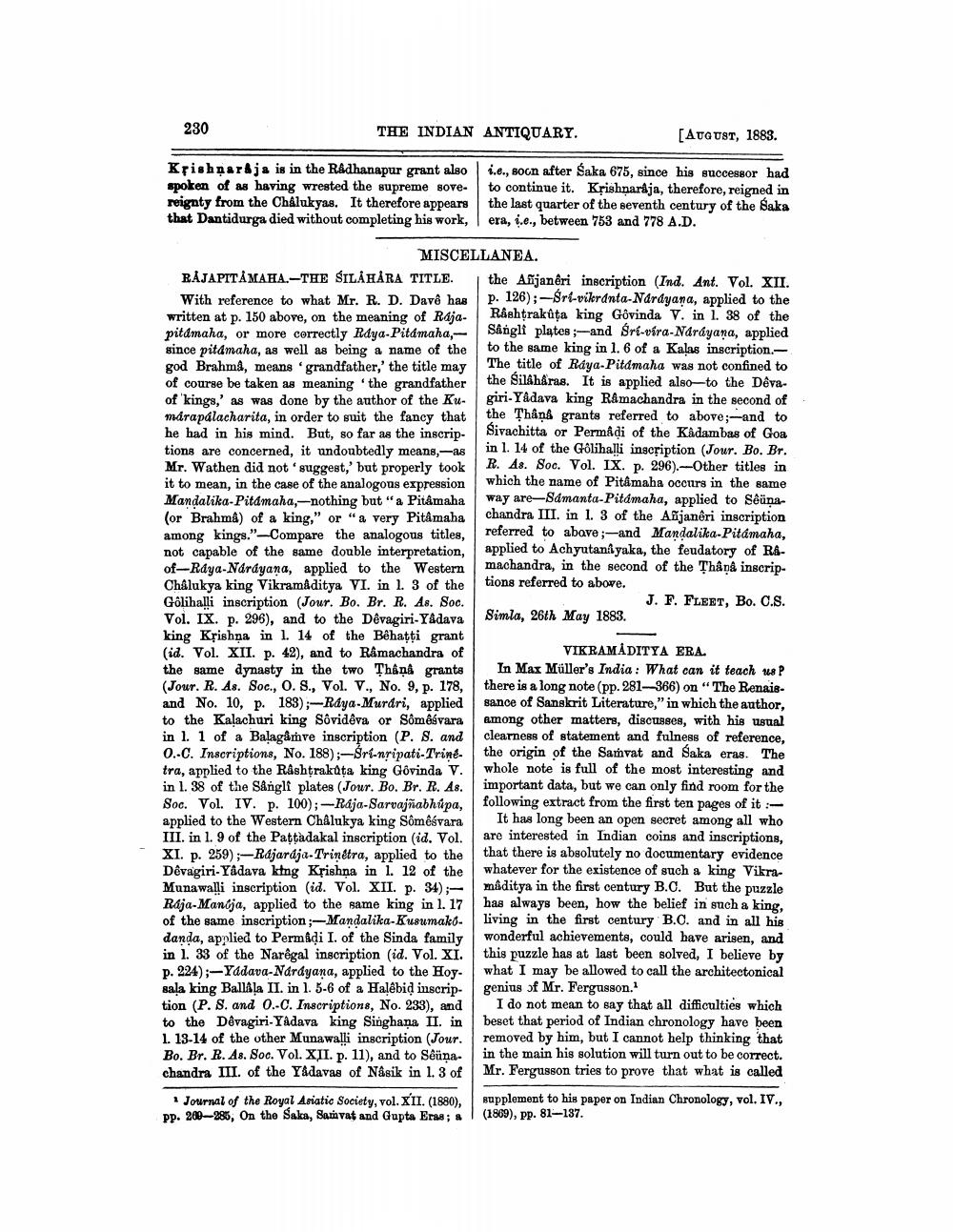________________
230
THE INDIAN ANTIQUARY.
[AUGUST, 1883.
Kishṇardja is in the Rådhanapur grant also spoken of as having wrested the supreme sove reignty from the Chalukyas. It therefore appears that Dantidurga died without completing his work,
i.e., bocn after Saka 675, since his successor had to continue it. Krishnaraja, therefore, reigned in the last quarter of the seventh century of the Saka era, e., between 753 and 778 A.D.
MISCELLANEA. RÅJAPITÅMAHA.-THE SILÅ HÅRA TITLE. the Añijanêri inscription (Ind. Ant. Vol. XII.
With reference to what Mr. R. D. Davô has p. 126);-Sri-vikranta-Ndrdyana, applied to the written at p. 150 above, on the meaning of Raja- Rashtrakūta king Govinda V. in l. 38 of the pitamaha, or more correctly Rdya-Pitamaha, Sångli plates ;-and Sri-vira-Ndráyana, applied since pitamaha, as well as being a name of the to the same king in l. 6 of a Kalas inscription. god Brahmå, means 'grandfather,' the title may
The title of Raya-Pitamaha was not confined to of course be taken as meaning the grandfather
the Silháras. It is applied also-to the Dêvaof kings' as was done by the author of the Ku giri.Yadava king Ramachandra in the second of mdrapálacharita, in order to suit the fancy that the Thåns grants referred to above;--and to he had in his mind. But, so far as the inscrip- Sivachitta or Permadi of the Kadambas of Goa tions are concerned, it undoubtedly means, -as in l. 14 of the Gôlihalli inscription (Jour. Bo. Br. Mr. Wathen did not suggest,' but properly took R. As. Soc. Vol. IX. p. 296).--Other titles in it to mean, in the case of the analogous expression
which the name of Pitamaha occurs in the same Mandalika-Pitamaha, -nothing but "a Pitamaha way are-Samanta Pitamaha, applied to Sdüna(or Brahma) of a king," or "a very Pitamaha
chandra III. in 1. 3 of the Añjanêri inscription among kings." - Compare the analogous titles, referred to above ;-and Mandalika-Pitamaha, not capable of the same double interpretation, applied to Achyutanayaka, the feudatory of RAof-Raya-Narayana, applied to the Western machandra, in the second of the Thana inscripChalukya king Vikramaditya VI. in l. 3 of the tions referred to above. Gôlihalli inscription (Jour. Bo. Br. R. As. Soc.
J. F. FLEET, Bo. C.S. Vol. IX. p. 296), and to the Dêvagiri-Yådava Simla, 26th May 1883. king Krishna in l. 14 of the Bêhatti grant (id. Vol. XII. p. 42), and to Ramachandra of
VIKRAMADITYA ERA. the same dynasty in the two Thân grants In Max Müller's India : What can it teach w P (Jour. R. As. Soc., 0. S., Vol. V., No. 9, p. 178, there is a long note (pp. 281-366) on "The Renaisand No. 10, p. 183);-Raya-Murdri, applied sance of Sanskrit Literature," in which the author, to the Kalachuri king Sôvideva or Sômêsvara among other matters, discusses, with his usual in l. 1 of a Balagámve inscription (P. 8. and clearness of statement and fulness of reference, 0.-C. Inscriptions, No. 188);-Sri-nripati-Trint. the origin of the Samvat and Saka eras. The tra, applied to the Rashtrakata king Govinda V. whole note is full of the most interesting and in 1. 38 of the Sångli plates (Jour. Bo. Br. R.As. important data, but we can only find room for the Soc. Vol. IV. p. 100); -Rája-Sarvajñabhúpa, following extract from the first ten pages of it :
pplied to the Western ChAlukya king Sômêsvara It has long been an open secret among all who III. in 1. 9 of the Pattadakal inscription (id. Vol.
are interested in Indian coins and inscriptions, XI. p. 259);-Rájardja-Trinetra, applied to the that there is absolutely no documentary evidence Dêvagiri-Yadava king Krishna in l. 12 of the whatever for the existence of such a king VikraMunawalli inscription (id. Vol. XII. p. 34);- maditya in the first century B.C. But the puzzle Raja Manoja, applied to the same king in 1. 17 has always been, how the belief in such a king, of the same inscription ;-Mandalika-Kusumako. living in the first century B.C. and in all his danda, applied to Permadi I. of the Sinda family wonderful achievements, could have arisen, and in l. 33 of the Narêgal inscription (id. Vol. XI. this puzzle has at last been solved, I believe by p. 224);-Yadava-Nardyana, applied to the Hoy- what I may be allowed to call the architectonical sala king Ballkla II. in l. 5-6 of a Halebid inscrip- genius of Mr. Fergusson. tion (P. S. and 0.-C. Inscriptions, No. 233), and I do not mean to say that all difficulties which to the Dêvagiri-Yadava king Singhaņa II. in beset that period of Indian chronology have been 1 18.14 of the other Munawalli inscription (Jour. removed by him, but I cannot help thinking that Bo. Br. R. As. Soc. Vol. XII. p. 11), and to Séüņa. in the main his solution will turn out to be correct. chandra III. of the Yadavas of Nasik in 1. 3 of Mr. Fergusson tries to prove that what is called
1 Journal of the Royal Aviatic Society, vol. XII. (1880), pp. 200-28%, On the Saka, Samvat and Gupta Eras; a
supplement to his paper on Indian Chronology, vol. IV., (1809), pp. 81-137.




